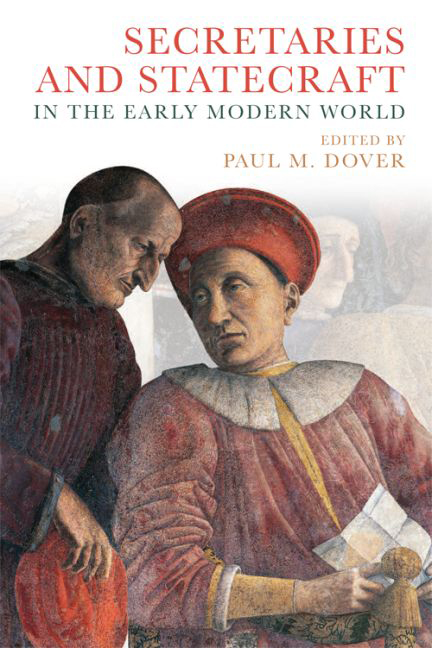Book contents
- Frontmatter
- Contents
- List of Contributors
- 1 Introduction: The Age of Secretaries
- 2 Records, Politics and Diplomacy: Secretaries and Chanceries in Renaissance Italy (1350–c. 1520)
- 3 Mercurino di Gattinara (1465–1530): Imperial Chancellor, Strategist of Empire
- 4 ‘This continuous writing’: The Paper Chancellery of Bernhard Cles
- 5 Parables and Dark Sentences: The Correspondence of Sir William Cecil and William Maitland (1559–73)
- 6 Axel Oxenstierna and Swedish Diplomacy in the Seventeenth Century
- 7 Statecraft and the Role of the Diplomat in Ducal Savoy: The Career of Alessandro Scaglia (1592–1641)
- 8 Richelieu, Mazarin and Italy (1635–59): Statesmanship in Context
- 9 The Learned Ideal of the Mughal Wazīr: The Life and Intellectual World of Prime Minister Afzal Khan Shirazi (d. 1639)
- 10 Reconsidering State and Constituency in Seventeenth-Century Safavid Iran: The Wax and Wane of the Munshi
- 11 Choreographers of Power: Grigorii Kotoshikhin, State Secretaries and the Muscovite Royal Wedding Ritual
- 12 Eberhard von Danckelman and Brandenburg's Foreign Policy (1688–97)
- 13 Chancellor of State: Prince Wenzel Anton Kaunitz, the Habsburg Foreign Office and Foreign Policy in the Era of Enlightened Absolutism
- Index
7 - Statecraft and the Role of the Diplomat in Ducal Savoy: The Career of Alessandro Scaglia (1592–1641)
Published online by Cambridge University Press: 21 November 2017
- Frontmatter
- Contents
- List of Contributors
- 1 Introduction: The Age of Secretaries
- 2 Records, Politics and Diplomacy: Secretaries and Chanceries in Renaissance Italy (1350–c. 1520)
- 3 Mercurino di Gattinara (1465–1530): Imperial Chancellor, Strategist of Empire
- 4 ‘This continuous writing’: The Paper Chancellery of Bernhard Cles
- 5 Parables and Dark Sentences: The Correspondence of Sir William Cecil and William Maitland (1559–73)
- 6 Axel Oxenstierna and Swedish Diplomacy in the Seventeenth Century
- 7 Statecraft and the Role of the Diplomat in Ducal Savoy: The Career of Alessandro Scaglia (1592–1641)
- 8 Richelieu, Mazarin and Italy (1635–59): Statesmanship in Context
- 9 The Learned Ideal of the Mughal Wazīr: The Life and Intellectual World of Prime Minister Afzal Khan Shirazi (d. 1639)
- 10 Reconsidering State and Constituency in Seventeenth-Century Safavid Iran: The Wax and Wane of the Munshi
- 11 Choreographers of Power: Grigorii Kotoshikhin, State Secretaries and the Muscovite Royal Wedding Ritual
- 12 Eberhard von Danckelman and Brandenburg's Foreign Policy (1688–97)
- 13 Chancellor of State: Prince Wenzel Anton Kaunitz, the Habsburg Foreign Office and Foreign Policy in the Era of Enlightened Absolutism
- Index
Summary
How was foreign policy made and conducted in early modern Europe? As this volume suggests, this is at once a very broad question and a multifaceted one. It belies a host of fundamental issues that touch on what even constituted ‘foreign’ policy; who was thought to have the right to decide policy; the logistics of actuating particular policies given the perennial early modern challenges of distance and time, coupled with the issue of how information was collected and digested; and how those serving as diplomats in the field might shape policy and the styles of diplomacy through their personal interests and character traits. While these questions naturally flow into each other, this chapter will principally address the last one, that of the role of the diplomat as a creative agency of foreign policy-making. More specifically, this chapter examines these issues through one ambassador, Alessandro Scaglia (1592–1641), who was in formal service to the ducal House of Savoy from 1614 until his self-imposed exile to the Spanish Netherlands in 1632. Importantly, in its early modern context, the question of ‘foreign policy-making’ both addresses and challenges a conception of international relations as a sphere of political activity monopolised by sovereign powers, and serviced by faceless bureaucrats. As we will see, the practice of diplomacy between states, or rather the practice of relations between princes given that dynastic states predominated, was profoundly influenced by its practitioners, who brought their social, cultural and family interests to their diplomatic activity.
This is more than evident in the case of Alessandro Scaglia, an individual of noble birth and a commendatory abbot of the Roman Church. He was the opposite of an anonymous bureaucrat, his recognisable image visually fixed by the series of portraits he commissioned from Anthony van Dyck, dating from the mid-1630s, and possibly one from 1627 or 1628. We should add that van Dyck planned to include one of the portraits for the Iconographia (posthumously published in 1645), his collection of engravings of leading figures in the realms of the court, politics and the arts based on his own paintings, meant for a commercial market interested in having images of the famous by an equally famous artist.
- Type
- Chapter
- Information
- Secretaries and Statecraft in the Early Modern World , pp. 140 - 154Publisher: Edinburgh University PressPrint publication year: 2016



